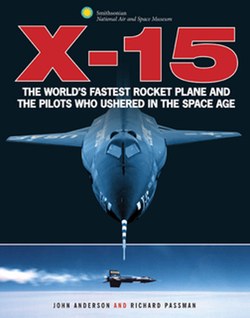Review: X-15by Jeff Foust
|
| This relatively short and heavily illustrated book does not go into the same level of detail as some other books, but still offers a very thorough history of the X-15 program. |
In many respects, though, these vehicles pale in comparison to another rocket-powered spaceplane that flew over the same Mojave skies a half-century ago: the X-15. It flew as high as SpaceShipTwo and Lynx will eventually go, and far faster too, setting speed records that stand to this day. The X-15’s flights provided insights into hypersonic flight that guided the development of the Space Shuttle. Moreover, in the eyes of many, it serves as a symbol of what might have been in human spaceflight had the US decided to continue development of winged vehicles for reaching space, rather than developing capsules for launch atop converted missiles when the Space Race began in earnest.
The new book X-15: The World's Fastest Rocket Plane and the Pilots Who Ushered in the Space Age by John Anderson, a curator at the Smithsonian’s National Air and Space Museum, and Richard Passman, a volunteer historian there, is designed to be an introduction to the X-15 and a “companion” to the X-15 that is on display at the museum. As such, the relatively short (less than 150 pages) and heavily illustrated book does not go into the same level of detail as some other books, including last year’s The X-15 Rocket Plane (see “Review: The X-15 Rocket Plane”, The Space Review, July 22, 2013).
Nonetheless, this book still offers a very thorough history of the X-15 program. Anderson and Passman go back to the 1930s and the desire by engineers at NASA’s predecessor, NACA, to develop an experimental plane to study flight in the transonic regime around Mach 1. It wasn’t until after World War II that the US built the X-1 rocketplane that broke the sound barrier, kicking off a series of experimental aircraft that led up to the X-15. In later chapters, they describe the development of the X-15, recount some of its key missions, and profile the men who flew the X-15 on its 199 flights.
“The X-15 remains the fastest and highest-flying manned airplane in history,” Anderson and Passman write in the book’s conclusion, a claim that is only partially correct: on its final flight in October 2004, SpaceShipOne broke the altitude record set by Joe Walker on an August 1963 X-15 flight, going to an altitude of 112 kilometers. (There is no mention of SpaceShipOne or other recent rocket-powered aircraft developments, and only a brief mention in passing the remotely-piloted X-51 hypersonic vehicle at the end of the book.) That is, perhaps, one of the few flaws in a book that is otherwise a concise, yet detailed, introduction to the X-15. As rocket-powered aircraft take to the skies again this year above the Mojave Desert, this book reminds us of another era of such vehicles—and, perhaps, what might have been.
